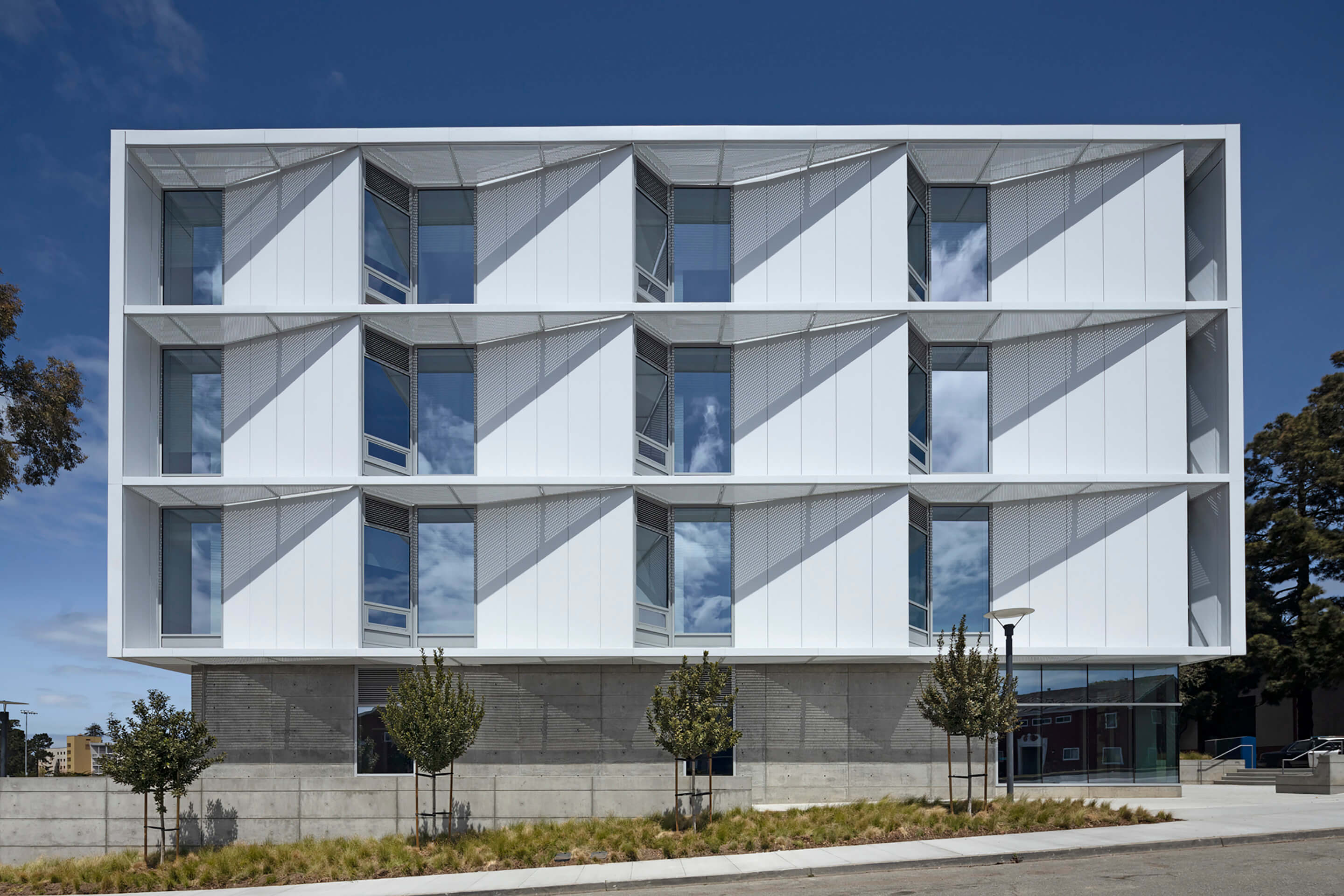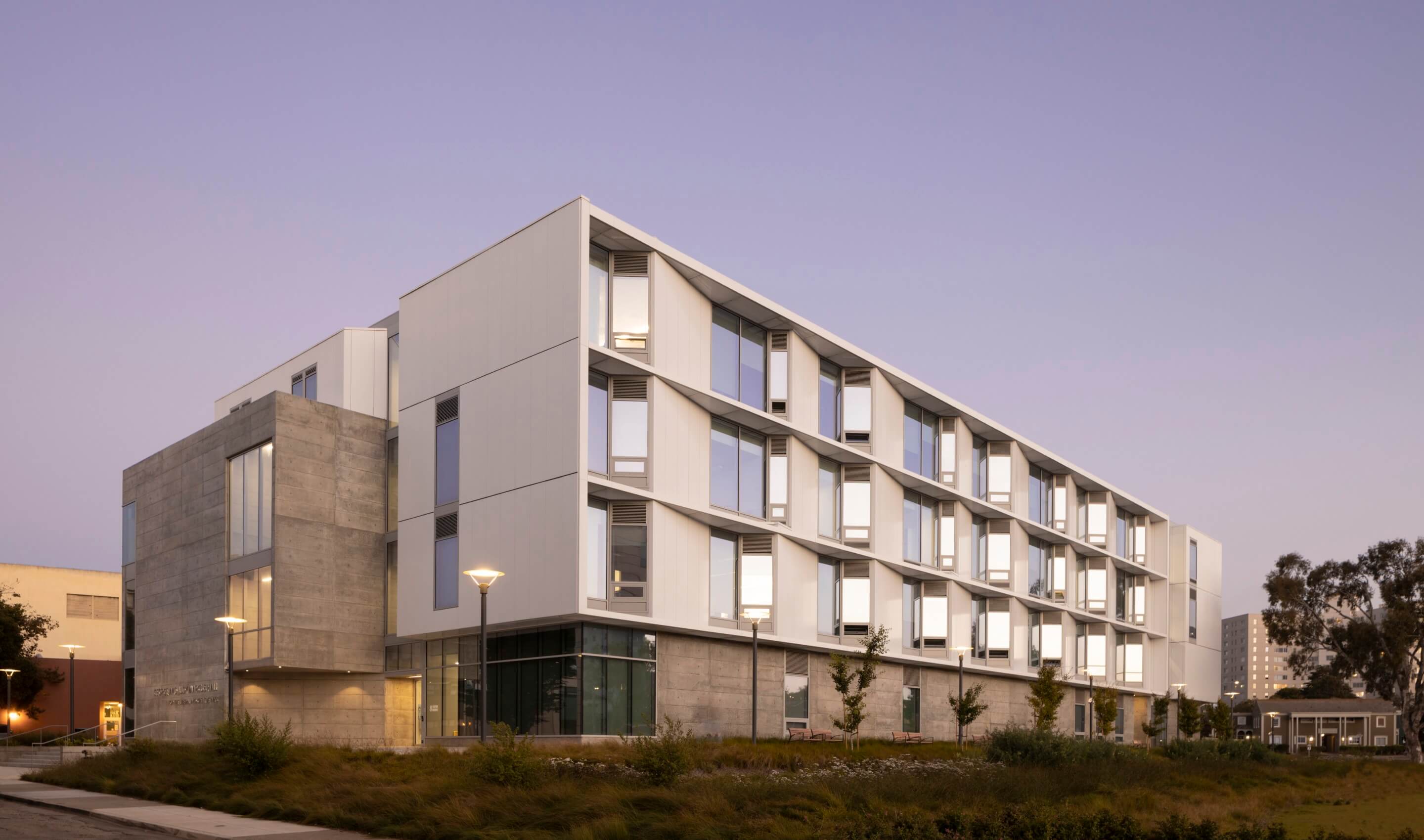
San Francisco State University has a new academic building for the first time in 25 years: The George and Judy Marcus Hall for the Liberal and Creative Arts. Designed by the San Francisco-based Mark Cavagnero Associates as a flexible learning and production environment, the four-story facility asserts the presence of the arts on campus. Located on a highly trafficked quad, the building offers passersby views into its television news studio on its first floor, inviting the outside in.
Marcus Hall is a state-of-the-art facility and a testament to the strength of SF State’s Broadcast and Electronic Arts (BECA) program. Through a thoughtful design process on a constrained triangular site, Cavagnero opens the building up to campus with a stunning facade and a high level of transparency for the department that was formerly housed in a bunker-like, perfunctory concrete Brutalist box.

- Architect
Mark Cavagnero Associates - General Contractor
McCarthy Building Companies, Inc. - Location
San Francisco - Completion Date
Fall 2021 - MEP / LEED Engineer
WSP - Structural Engineer
Forell/Elsesser - Curtain Wall
Kawneer - Landscape:
SWA Group - Glazing
Viracon (dual glazed for broadcast and recording areas) - Metal Panels
Centria - Architectural Lighting
Auerbach Glasow Acoustics
“It has been an honor to work with SF State to design and realize the university’s first new academic building in more than two decades,” said Mark Cavagnero. “Marcus Hall provides a range of versatile spaces to spark innovation and collaboration, with state-of-the-art technology. I hope this new building inspires students and provides them with a space to learn, experiment, and create.”
Cavagnero’s design balances the BECA department’s multidisciplinary and technical needs through a hybrid form, combining glass, steel, and concrete. Maximizing open and flexible space, accessibility, and transparency, the structure uses concrete to support acoustics and limit vibration, and carve out a range of spaces, from large production studios to intimate labs. This was juxtaposed with concrete, glass, and steel that lighten the building’s presence to create a strong feeling toward its neighbors.
Marcus Hall houses SF States Broadcasting and Electronic Arts Department which required particular attention to programmatic and material concerns in the project. The design balances both the students’ needs and the diverse needs of the building’s program. John Fung, Principal at Mark Cavagnero Associates said that “The broadcast and recording functions are typically housed in ‘black box’ environments and formerly were located in a basement, far away from public view. We set out to bring greater visibility to this program by introducing ground floor transparency into the new building”

Visual connectivity through adjoining classrooms and circulation spaces allows students and visitors to see more clearly into the production environments and access to these specialized learning spaces. Marcus Hall includes:
- Two 4k-capable multistory television studios;
- A high-definition broadcast news studio with robotic cameras;
- A sound design studio with acoustics for recording, mixing and mastering in surround sound, capable of ADR, SFX editing, and audio restoration;
- The KSFS broadcast student radio station;
- Multimedia digital editing suites and classrooms; and
- A 100-seat flexible, video wall-equipped media presentation space.
The high-performance envelope and exterior cladding maximize daylight and views for office and instructional spaces while balancing thermal gain and loss, and naturally ventilated spaces wherever possible through operable windows and grilles throughout the facade system consisting of a brise soleil and folded openings on the south and west side while Centria metal panels create a smooth contrast with the concrete. Glass lightens its sculptural form, inviting the campus in and creating a feeling of openness, while special double glazed Viricon windows also support the acoustics requirements. Fung states that “the interlocking of the light metal skin with the concrete base gives the building a clear expression of purpose.” The effects of the afternoon sun on the south and west facades with the afternoon sun lends the building a kinetic visual impact.
When asked about what drove the material palette for this project, John Fung replied that it was “driven by the intent to bring functional clarity to the building, with each material responding appropriately to the program requirements.” With a curtain wall by Kawneer, the building is organized by glazed classrooms and offices, which wrap around the larger concrete volume of the broadcast and recording spaces. The concrete mass provides vibration control and acoustic separation from the urban campus environment, though the glass and metal envelope is sculpted to draw in daylight and direct views in and out of the classroom and office spaces.

Fung noted that Marcus Hall was sited on a triangular plot to leverage its proximity to an existing scene shop in the adjacent theater building, providing ease of loading access, as well as maximizing remaining open space for future site utilization. The compact footprint also provides clear points of entry and greater visibility for the larger campus in what was previously a visually narrow and uninviting concrete thoroughfare.
Marcus Hall is LEED Gold Certified in line with SF State’s commitment to resilient and sustainable development employing a passive energy design to efficiently mitigate the region’s microclimate.


